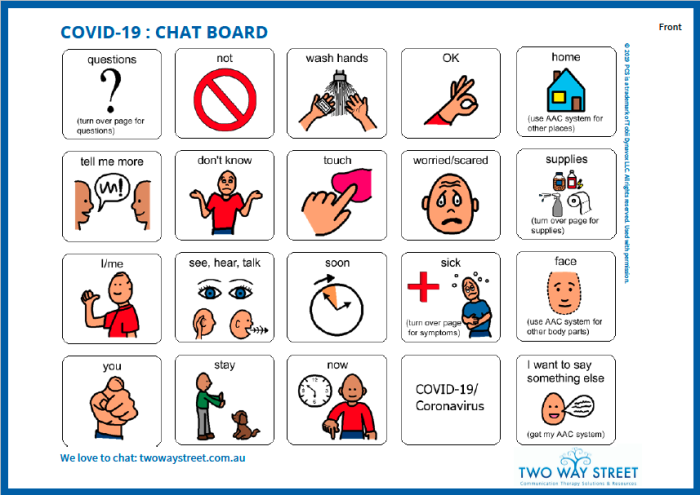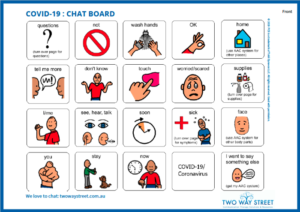AAC users4 February 2021

“Kids worry more when they’re kept in the dark”
Rachel Ehmke, Child Mind Institute
This blog post was written in March 2020.
With the outbreak and ongoing uncertainty of the Coronavirus/COVID-19, we feel it is important to provide resources and ideas to ensure those who have communication challenges also get the information they need.
Please download our aided language display (available at the end of this article) designed specifically to support these conversations. Please note that this is a general resource and may need to be personalised or modified to suit your child/person’s vocabulary and/or layout of their system. You may need to reduce the number of items, program the vocabulary onto their device, or use partner assisted scanning rather than pointing. Please talk to your speech pathologist or AAC specialist if you have questions in relation to this process.
Give the facts:
The recommendations from experts is to buffer children from the ongoing news feed about Coronavirus, but it’s also important to give them the facts at a level that suits their age and understanding.
With the changing face of the virus, we can’t make a display that covers all of the facts. We suggest that you stay updated with credible news sites and use your child/person’s system to talk about additional facts that are not on our display. For example, this might be a good time to explore countries of the world, and talk about them. If you don’t have them, maybe add them to your system or onto the places list if using PODD.
Talk about what you can do:
“ Teaching kids what they can do to keep themselves and others safe is a positive way to make them feel empowered”
We’ve provided vocabulary to talk about the virus but more importantly, the recommendation from experts is to talk to your children about what you are doing to stay safe.
For example (words in bold are what you would model on your AAC system whilst speaking the whole phrase):
Check in and keep talking
Take an opportunity of time to talk about the virus with your child/person who uses AAC. By using the display provided and also their own system, you can help to show them the words they might need to use to ask questions or tell you things that they already know about it.
You might also model to them questions they might be thinking about.
For example:
It’s not something you need to talk about constantly, but it is important to update when needed or check in occasionally. Remember, the intention is not to scare your child/person into panic, but it is to acknowledge that they are likely hearing people talk about this virus. Maybe on the radio, people at school (students or staff), or within your home. Just because you are not talking to them, it doesn’t mean they are not hearing things. The power and control for them (and for all of us) is in asking questions and talking about it.
Through conversation we learn more and gain the information we need to feel in control.

Aided language display for augmentative and alternative communication AAC to talk about Coronavirus or COVID-19
Download our free COVID-19 aided language display
There are 2 pages to the ALD as it is intended to be a double-sided board. Printing each page and laminating them together is the most robust method for regular use.
Suggestions and information in this blog post are based on the following website information:
